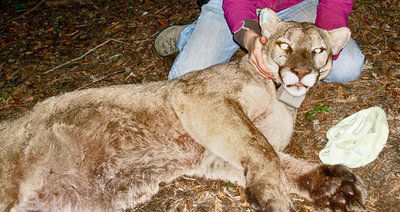
It was a few minutes before midnight when I pulled onto my property in the Santa Cruz Mountains. There, captured in the bright car lights, was an adult, un-collared mountain lion looking up into a madrone tree. As I stopped, the cat turned and walked deliberatively back into the thick forest.
I was thrilled to see up close the last species of large predators where we live and an animal I revere. We can be proud to know that California is the only western state that protects pumas from being killed.
However, recently a woman told me that one of her neighbors lost a goat to a mountain lion and the community was furious. I asked if the owner was going to get a permit to kill the cat and she said she hoped so.
“Pumas pose almost no danger to humans, but they will not always be able resist an easy meal of sheep or goats,” says Yiwei Wang of the UCSC Puma Project. “To help protect livestock and pumas, we encourage mountain residents to apply simple measures like putting goats and sheep in an enclosed structure at night. Not only will this protect our animals from becoming a puma’s next meal, it will also save a puma from eating its final meal.”
The Project lost two collared lions last Thanksgiving who were killed for eating domestic animals.
After the team captures an animal, they attach a state-of-the-art GPS wildlife-tracking collar that tracks the location and behavior of the mountain lion wearing it. With this data, the Puma Project works with local governments and non governmental organizations to identify conservation opportunities, like the placement of wildlife crossing structures across major freeways. Much of mountain lion habitat has been fragmented by human development.
Although the doctoral students in the program experience many fruitless and sleepless nights in the wild waiting to capture a cat with their cage and road kill deer bait, recently one was practically given to them. Chris Wilmers who heads up the Puma Project, got a call that a mountain lion was contained in a Santa Cruz aqueduct. He and his committed researchers were able to dart it and tranquilize it — a textbook example on how to handle wildlife in a populated area.
“We took it to a better location to collar it and take it back into the woods to let it go,” says Veronica Yovovich of the Puma Project. “We actually had a spot where the resident male that we had collared had died.”
That cat, who became famous for successfully crossing Highway 17 so many times, was one of two pumas shot last Thanksgiving.
The team named the new mountain lion 39M.
“It was a great success story,” Yovovich said. “We were able to work with California Fish and Wildlife and the police. There were a lot of people from the public, and it was amazing that with all the people there, people were very quiet and respectful. They just let us do our job. We’re really excited to see where he settles down and makes a territory.”
From the data collected so far, Yovovich thinks he may have made a deer kill.
This story, which so far has had a successful ending, stands in contrast to last year’s killing of two mountain lion kittens in Half Moon Bay. State Fish and Wildlife officials initially described the animals as a possible threat to the neighborhood, but the animals were later found to be no more than four months old and about the size of housecats.
Public outrage has spurred new legislation, SB 132, sponsored by Senator Jerry Hill of San Mateo County. According to the Mountain Lion Foundation in Sacramento, “Under the bill, Fish and Wildlife wardens would be required to attempt nonlethal means to remove a mountain lion perceived as a threat to public health or safety. Such means could include capturing, pursuing, anesthetizing, marking, monitoring, relocating, hazing, re-releasing and other options, according to the bill.”
The animal could be killed if it “can reasonably be expected to cause immediate death or physical harm,” according to the bill.
In the last few days SB 132 has cleared the state Senate and is moving on to be heard by the Assembly. If you would like to support the bill locally, contact Senator Bill Monning and Assemblyman Mark Stone or www.mountainlion.org.
Wang and Yovovich have been leading free mountain lion walks for five years as part of an environmental education grant I have received from the San Lorenzo Valley Water District. If you would like to join us on June 15 at Loch Lomond, please contact me at ca****@*********on.com. Space is limited.
– Carol Carson is a writer, naturalist, and educator.












